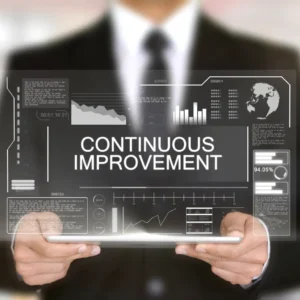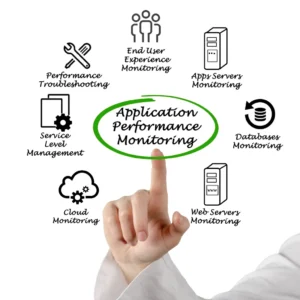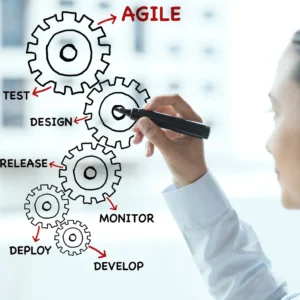
Mastering Success
A Comprehensive Guide to Maximizing ROI in IPA through Adaptive Monitoring and Strategic Adjustments
Embark on a transformative journey into Intelligent Process Automation (IPA) with our comprehensive guide, “Mastering Success: A Comprehensive Approach to Cost-Benefit Analysis in IPA.”
In this dynamic landscape, success hinges on a strategic fusion of innovation, adaptability, and ethical considerations. Our exploration begins with a meticulous focus on cost identification and classification, followed by an in-depth analysis of benefit definition and quantification.
Delve into ROI calculation methodologies and risk assessment and mitigation strategies to fortify your IPA initiatives. Navigate the temporal dimensions with a spotlight on timeframe considerations and scalable solutions.
Explore sensitivity analysis, comparative assessments, and integrating social and environmental considerations for a holistic approach. Finally, embrace the future with insights into continuous monitoring and adjustment.
Elevate your IPA endeavours through our user-centric, compliance-driven, and results-oriented guide, charting a course towards unparalleled success in the rapidly evolving landscape of Intelligent Process Automation.
Table of Contents

Arindam Roy
An Automation Consultant with 25+ years of IT Experience
Cost Identification and Classification
Navigating Complexity: A Comprehensive Approach to Cost Identification and Classification in IPA
An effective cost identification and classification strategy is pivotal in the intricate landscape of Intelligent Process Automation (IPA). This strategic framework outlines a comprehensive approach to identify and classify costs associated with IPA implementation systematically.
Strategic Framework for Cost Identification and Classification in Intelligent Process Automation (IPA):
Begin by establishing a strategic framework that guides the systematic identification and classification of costs. This overarching plan provides a roadmap for precision in cost assessment.
Comprehensive Criteria for Systematically Identifying Costs Associated with IPA Implementation:
Implement criteria that leave no stone unturned. Comprehensive guidelines ensure that all direct or indirect costs are systematically identified and accounted for in the IPA ecosystem.
Protocols for Distinguishing Between Upfront, Ongoing, and Hidden Costs in Automation Initiatives:
Craft protocols that enable a nuanced understanding of costs. Distinguish between upfront investments, ongoing operational expenses, and those elusive hidden costs that may surface over time.
Balancing Automation and Human Oversight through Rigorous Cost Identification and Classification Strategies:
Maintain equilibrium between automation and human oversight. Rigorous strategies should be in place to balance the efficiency gains from automation with the vigilance required in cost identification and classification.
Dynamic Assessment for Adapting to Evolving Cost Structures and Business Environments:
Acknowledge the dynamic nature of costs. Implement a dynamic assessment mechanism to adapt to evolving cost structures and the ever-changing landscape of business environments.
Governance Frameworks for Ethical and Transparent Implementation of Cost Identification in IPA:
Integrate governance frameworks to ensure ethical and transparent cost identification practices. Uphold standards that foster trust among stakeholders, emphasizing transparency and ethical conduct.
Proactive Measures for Ensuring Accuracy and Precision in Cost Identification Processes:
Proactively address accuracy challenges. Implement measures that enhance precision in cost identification processes, minimizing the margin for errors and ensuring reliable financial insights.
Adaptive Cost Identification Protocols Tailored to Varied Automation Scenarios and Business Environments:
Recognize the diversity in automation scenarios. Develop adaptive protocols tailored to suit the specific needs of varied automation scenarios and diverse business environments.
User-centric Design Principles for Ensuring Cost Identification Aligns with User Expectations:
Prioritize user experience in cost identification. Employ user-centric design principles to ensure the cost identification process aligns seamlessly with user expectations, facilitating user engagement and understanding.
Ensuring Compliance with Cost Identification and Classification Standards and Best Practices in the Context of IPA Implementation:
Adhere to industry standards and best practices. Implement measures that ensure compliance with established cost identification and classification standards, fostering consistency and reliability in financial assessments.
By adopting this comprehensive approach, organizations can navigate the complexities of cost identification and classification in IPA implementation. The synergy between strategic planning, dynamic adaptability, ethical governance, and user-centric design principles creates a robust framework that tests evolving business landscapes and technological advancements.
Benefit Definition and Quantification in IPA
Unlocking Value: A Holistic Approach to Benefit Definition and Quantification in IPA
In Intelligent Process Automation (IPA), a strategic framework is essential for defining and quantifying benefits. This comprehensive approach incorporates protocols for evaluating tangible and intangible gains in automation initiatives.
Strategic Framework for Benefit Definition and Quantification in Intelligent Process Automation (IPA):
Initiate with a strategic framework that guides the definition and quantification of benefits. This foundational plan sets the stage for a meticulous assessment of the value derived from IPA implementation.
Comprehensive Criteria for Defining and Quantifying Benefits Expected from IPA Implementation:
Implement comprehensive criteria that leave no benefit unaccounted for. Ensure a thorough examination of expected benefits, encompassing direct and indirect contributions to organizational goals.
Protocols for Assessing Both Tangible and Intangible Benefits of Automation Initiatives:
Craft protocols to assess the diverse spectrum of benefits. From measurable, tangible gains to intangible enhancements, these protocols guarantee a well-rounded evaluation, capturing the full spectrum of IPA impact.
Balancing Automation and Human Oversight through Rigorous Benefit Definition and Quantification Strategies:
Maintain equilibrium between automation and human insight. Rigorous strategies balance the quantitative gains of automation with qualitative insights, ensuring a holistic understanding of benefits.
Dynamic Evaluation for Adapting to Evolving Business Goals and Technological Advancements:
Embrace dynamism in benefit evaluation. Implement a dynamic assessment process that adapts to evolving business goals and technological advancements, ensuring relevance and currency in benefit quantification.
Governance Frameworks for Ethical and Transparent Implementation of Benefit Assessment in IPA:
Integrate governance frameworks to ensure ethical and transparent benefit assessment. Uphold standards that foster trust, emphasizing transparency and ethical conduct throughout the evaluation process.
Proactive Measures for Ensuring Comprehensive Assessment of Benefits Across Automation Workflows:
Proactively address the challenge of comprehensive assessment. Implement measures encompassing benefits across diverse automation workflows, leaving no aspect in the evaluation.
Adaptive Benefit Definition and Quantification Protocols Tailored to Varied Automation Scenarios:
Recognize the diversity in automation scenarios. Develop adaptive protocols that tailor benefit definition and quantification to suit varied automation contexts, ensuring relevance and accuracy.
User-centric design Principles for Ensuring Benefit Assessment Aligns with User Experience Goals:
Prioritize user experience in benefit assessment. Apply user-centric design principles to align the assessment process with user expectations, facilitating better comprehension and engagement.
Ensuring Compliance with Benefit Definition and Quantification Standards and Best Practices in the Context of IPA Implementation:
Adhere to industry standards and best practices. Ensure compliance with established benefit definition and quantification standards, fostering consistency and reliability in assessing the impact of IPA on organizational objectives.
This holistic approach guarantees a nuanced understanding of the multifaceted benefits of Intelligent Process Automation, creating a foundation for strategic decision-making and sustainable organizational growth.
ROI Calculation Methodologies
Unlocking Value: Strategic ROI Calculation Methodologies in Intelligent Process Automation (IPA)
A robust approach to ROI calculation in Intelligent Process Automation (IPA) is pivotal for organizations seeking a comprehensive understanding of their investments. This strategic framework delineates methodologies, protocols, and proactive measures for accurate and consistent ROI assessment.
Strategic Framework for ROI Calculation Methodologies in Intelligent Process Automation (IPA):
Initiate a strategic framework to guide ROI calculation methodologies. This overarching plan provides direction for selecting, applying, and adapting ROI methods tailored to IPA’s dynamic landscape.
Comprehensive Criteria for Selecting and Applying ROI Calculation Methods in Automation Initiatives:
Implement comprehensive criteria for method selection. Ensure that chosen ROI calculation methods align with the unique attributes of automation initiatives, providing a nuanced understanding of returns.
Protocols for Ensuring Accuracy and Consistency in Calculating Return on Investment for IPA:
Craft protocols to ensure precision in ROI calculations. Maintain consistency in data inputs and methodologies to yield reliable and accurate assessments of investment returns in IPA.
Balancing Automation and Human Oversight through Rigorous ROI Calculation Methodologies:
To achieve success, finding a balance between using automation and human insight is important. Both have strengths and limitations, so it’s essential to use them together to complement each other. By doing so, you can ensure that you’re making the most of both worlds and that you can make the best decisions possible. Rigorous methodologies should blend the efficiency gains of automation with the critical oversight necessary for accurate ROI assessments.
Dynamic Evaluation for Adapting ROI Analysis to Evolving Business Environments and Objectives:
Embrace dynamism in ROI analysis. Implement a dynamic evaluation process that adapts to evolving business environments and objectives, ensuring relevance and currency in ROI assessments.
Governance Frameworks for Ethical and Transparent Implementation of ROI Calculation in IPA:
Integrate governance frameworks to ensure ethical and transparent ROI calculation. Uphold standards that foster trust, emphasizing transparency and ethical conduct throughout the calculation process.
Proactive Measures for Addressing Challenges and Ensuring Robust ROI Assessment:
Proactively address challenges in ROI assessment. Implement measures that preemptively tackle issues, ensuring a robust and reliable evaluation of investment returns in the context of IPA.
Adaptive ROI Calculation Protocols Tailored to Varied Automation Scenarios and Business Environments:
Recognize the diversity in automation scenarios. Develop adaptive protocols that tailor ROI calculation to suit varied automation contexts, providing a customized approach to assessing returns.
User-Centric Design Principles for Ensuring ROI Methodologies Align with User Expectations:
Prioritize user experience in ROI methodologies. Apply user-centric design principles to align ROI assessment with user expectations, facilitating better comprehension and engagement with the results.
Ensuring Compliance with ROI Calculation Standards and Best Practices in the Context of IPA Implementation:
Adhere to industry standards and best practices. Ensure compliance with established ROI calculation standards, fostering consistency and reliability in assessing the impact of IPA on organizational objectives.
This comprehensive framework for ROI calculation in IPA ensures organizations make informed decisions, maximizing the value derived from Intelligent Process Automation investments.
Risk Assessment and Mitigation
Safeguarding Success: Strategic Risk Assessment and Mitigation in Intelligent Process Automation (IPA)
When implementing Intelligent Process Automation (IPA), it’s essential to be proactive and comprehensive in assessing and mitigating potential risks. This involves using methodologies, protocols, and strategies that focus on the user’s needs to identify, evaluate, and minimize any risks that may arise during the implementation of IPA. By taking this strategic approach, you can ensure a safer and more successful implementation of IPA.
Strategic Framework for Risk Assessment and Mitigation in Intelligent Process Automation (IPA) Initiatives:
Establish a strategic framework to guide risk assessment and mitigation. This comprehensive plan ensures a systematic approach to identifying, evaluating, and addressing risks throughout the IPA lifecycle.
Comprehensive Criteria for Identifying and Evaluating Risks Associated with IPA Implementation:
Implement comprehensive criteria for risk identification and evaluation. Ensure a thorough examination of potential risks associated with IPA implementation, covering technological, operational, and regulatory aspects.
Protocols for Assessing the Impact of Risks on Cost-Benefit Projections and Project Success:
Craft protocols to assess the impact of identified risks. Evaluate how risks influence cost-benefit projections and project success, enabling informed decision-making and strategic adjustments.
Balancing Automation and Human Oversight through Rigorous Risk Management Strategies:
Maintain equilibrium between automation and human insight in risk management. Rigorous strategies should blend the efficiency gains of automation with the critical oversight necessary for practical risk assessment and mitigation.
Dynamic Evaluation for Adapting to Evolving Threats, Uncertainties, and Regulatory Changes:
Embrace dynamism in risk evaluation. Implement a dynamic assessment process that adapts to threats, uncertainties, and regulatory changes, ensuring ongoing relevance and effectiveness.
Governance Frameworks for Ethical and Transparent Implementation of Risk Assessment in IPA:
Integrate governance frameworks to ensure ethical and transparent risk assessment practices. Uphold standards that foster trust, emphasizing transparency and ethical conduct throughout the risk evaluation process.
Proactive Measures for Developing and Implementing Effective Risk Mitigation Strategies:
Proactively address potential risks. Implement measures that facilitate developing and implementing effective risk mitigation strategies, preventing and minimizing the impact of identified risks.
Adaptive Risk Assessment and Mitigation Protocols Tailored to Varied Automation Scenarios:
Recognize the diversity in automation scenarios. Develop adaptive protocols that tailor risk assessment and mitigation to suit varied automation contexts, providing a customized and context-specific approach.
User-Centric Design Principles for Ensuring Risk Management Aligns with User Experience Goals:
Prioritize user experience in risk management. Apply user-centric design principles to ensure risk management aligns seamlessly with user expectations, facilitating better comprehension and engagement.
Ensuring Compliance with Risk Assessment and Mitigation Standards and Best Practices in the Context of IPA Implementation:
Adhere to industry standards and best practices. Ensure compliance with established risk assessment and mitigation standards, fostering consistency and reliability in managing risks associated with IPA implementation.
Organizations can use a comprehensive risk management framework to strengthen their Intelligent Process Automation initiatives against potential difficulties. This ensures successful implementation and maximizes the benefits.
Timeframe Considerations
Mastering Time: A Strategic Guide to Timeframe Considerations in Intelligent Process Automation (IPA)
Understanding the temporal dimensions of cost-benefit analysis is crucial in the realm of Intelligent Process Automation (IPA). This strategic framework delves into criteria, protocols, and user-centric strategies for compelling timeframe considerations in IPA initiatives.
Strategic Framework for Timeframe Considerations in Intelligent Process Automation (IPA) Initiatives:
Initiate a strategic framework to guide timeframe considerations. This overarching plan ensures a systematic approach to determining appropriate timeframes for conducting cost-benefit analysis within IPA initiatives.
Comprehensive Criteria for Determining Appropriate Timeframes for Conducting Cost-Benefit Analysis:
Implement comprehensive criteria for timeframe determination. Ensure a thorough examination of project characteristics and objectives to establish appropriate timeframes for cost-benefit analysis.
Protocols for Considering Short-Term and Long-Term Impacts on Costs, Benefits, and Project Success:
Craft protocols for a nuanced evaluation of short-term and long-term impacts. Consider the dynamic interplay between costs, benefits, and overall project success, providing a holistic perspective on IPA outcomes.
Balancing Automation and Human Oversight through Rigorous Timeframe Planning and Evaluation:
Maintain equilibrium between automation and human insight in timeframe planning. Rigorous strategies should blend the efficiency gains of automation with the critical oversight necessary for practical evaluation over time.
Dynamic Assessment for Adapting Timeframe Considerations to Evolving Business Objectives:
Embrace dynamism in timeframe considerations. Implement a dynamic assessment process that adapts to evolving business objectives, ensuring alignment between analysis timeframes and organizational goals.
Governance Frameworks for Ethical and Transparent Implementation of Timeframe Analysis in IPA:
Integrate governance frameworks to ensure ethical and transparent timeframe analysis. Uphold standards that foster trust, emphasizing transparency and ethical conduct throughout the analysis process.
Proactive Measures for Anticipating and Addressing Timeframe Challenges and Opportunities:
Proactively address challenges in timeframe considerations. Implement measures anticipating and addressing potential challenges and opportunities, ensuring robust and reliable analysis outcomes.
Adaptive Timeframe Consideration Protocols Tailored to Varied Automation Scenarios:
Recognize the diversity in automation scenarios. Develop adaptive protocols that tailor timeframe considerations to suit varied automation contexts, providing a customized and context-specific approach.
User-Centric Design Principles for Ensuring Timeframe Analysis Aligns with User Expectations:
Prioritize user experience in timeframe analysis. Apply user-centric design principles to ensure timeframe considerations align seamlessly with user expectations, facilitating better comprehension and engagement.
Ensuring Compliance with Timeframe Consideration Standards and Best Practices in the Context of IPA Implementation:
Adhere to industry standards and best practices. Ensure compliance with established timeframe consideration standards, fostering consistency and reliability in conducting cost-benefit analysis within IPA initiatives.
By incorporating these comprehensive timeframe considerations, organizations can optimize their approach to cost-benefit analysis in IPA, aligning temporal dimensions with strategic goals and ensuring a robust foundation for decision-making.
Scalability and Expansion Analysis
Scaling Heights: A Strategic Guide to Scalability and Expansion Analysis in Intelligent Process Automation (IPA)
A strategic approach to scalability and expansion is paramount in the dynamic landscape of Intelligent Process Automation (IPA). This framework explores methods, protocols, and user-centric strategies for effective scalability and expansion analysis within IPA initiatives.
Strategic Framework for Scalability and Expansion Analysis in Intelligent Process Automation (IPA) Initiatives:
Commence with a strategic framework guiding scalability and expansion analysis. This plan ensures a systematic approach to analyzing the scalability of IPA solutions and evaluating their potential for expansion in alignment with organizational goals.
Comprehensive Criteria for Analyzing the Scalability of IPA Solutions and Automation Workloads:
Implement comprehensive criteria for scalability analysis. Ensure a thorough examination of IPA solutions and automation workloads, assessing their capacity to scale efficiently and accommodate growing demands.
Protocols for Assessing the Potential Expansion of IPA Initiatives to Accommodate Business Growth:
Craft protocols for evaluating potential expansion. Assess the impact of scaling IPA initiatives to accommodate business growth, ensuring a strategic alignment between automation capabilities and evolving business requirements.
Balancing Automation and Human Oversight through Rigorous Scalability and Expansion Evaluation:
Maintain equilibrium between automation and human insight in scalability evaluation. Rigorous strategies should blend the efficiency gains of automation with critical oversight, ensuring a balanced approach to expansion.
Dynamic Assessment for Adapting to Evolving Business Requirements and Technological Advances:
Embrace dynamism in scalability assessment. Implement a dynamic evaluation process that adapts to evolving business requirements and technological advances, ensuring scalability aligns with the pace of change.
Governance Frameworks for Ethical and Transparent Implementation of Scalability and Expansion Analysis in IPA:
Integrate governance frameworks for ethical scalability analysis. Uphold standards that ensure transparency and ethical conduct, fostering trust in the evaluation process for scalability and expansion.
Proactive Measures for Identifying and Preparing for Scalability Challenges and Opportunities:
Proactively address scalability challenges and opportunities. Implement measures that anticipate and prepare for potential scalability issues, ensuring proactive management of challenges and capitalizing on growth opportunities.
Adaptive Scalability and Expansion Analysis Protocols Tailored to Varied Automation Scenarios:
Recognize the diversity in automation scenarios. Develop adaptive protocols that tailor scalability and expansion analysis to suit varied automation contexts, providing a customized approach to accommodate diverse scenarios.
User-centric design Principles for Ensuring Scalability Analysis Aligns with User Experience Goals:
Prioritize user experience in scalability analysis. Applying user-centric design principles ensures scalability considerations align seamlessly with user expectations, facilitating better comprehension and engagement.
Ensuring Compliance with Scalability and Expansion Analysis Standards and Best Practices in the Context of IPA Implementation:
Adhere to industry standards and best practices. Ensure compliance with established scalability and expansion analysis standards, fostering consistency and reliability in preparing IPA initiatives for organizational growth.
By incorporating these comprehensive scalability and expansion considerations, organizations can strategically navigate growth opportunities, ensuring their IPA initiatives remain agile, efficient, and aligned with evolving business needs.
Sensitivity Analysis
Navigating Uncertainties: A Strategic Guide to Sensitivity Analysis in Intelligent Process Automation (IPA) Cost-Benefit Assessment
A strategic sensitivity analysis is pivotal for informed decision-making in the intricate landscape of Intelligent Process Automation (IPA), where uncertainties abound. This framework explores strategies, protocols, and user-centric approaches for conducting impactful sensitivity analysis within IPA initiatives.
Strategic Framework for Sensitivity Analysis in Intelligent Process Automation (IPA) Cost-Benefit Assessment:
Commence with a strategic framework for sensitivity analysis. This overarching plan ensures a systematic approach to assessing the impact of uncertainties on cost-benefit outcomes within the dynamic context of IPA initiatives.
Comprehensive Criteria for Identifying Key Variables and Factors Influencing IPA Initiatives:
Implement comprehensive criteria for variable identification. Ensure a thorough examination of critical variables and factors influencing IPA initiatives, providing a nuanced understanding of the elements crucial to sensitivity analysis.
Protocols for Conducting Rigorous Sensitivity Analysis to Assess Impact of Uncertainties:
Develop a clear and well-structured plan to analyze the impact of uncertainties on cost-benefit outcomes. This plan should include a systematic approach that evaluates potential variations in detail. To achieve this, we should create protocols for rigorous sensitivity analysis. It’s essential to assess the potential impact of uncertainties on the outcomes, ensuring a meticulous and detailed evaluation.
Balancing Automation and Human Oversight through Detailed Sensitivity Analysis Strategies:
Maintain equilibrium between automation and human insight. Employ detailed sensitivity analysis strategies that integrate the efficiency gains of automation with the critical oversight necessary for a comprehensive assessment.
Dynamic Assessment for Adapting to Varied Business Scenarios and Technological Changes:
Embrace dynamism in sensitivity assessment. Implement a dynamic evaluation process that adapts to varied business scenarios and technological changes, ensuring the relevance and adaptability of sensitivity analysis to evolving landscapes.
Governance Frameworks for Ethical and Transparent Implementation of Sensitivity Analysis in IPA:
Integrate governance frameworks for ethical sensitivity analysis. Uphold standards that ensure transparency and ethical conduct, fostering trust in implementing sensitivity analysis within IPA initiatives.
Proactive Measures for Addressing Sensitivity in Cost-Benefit Projections and Risk Mitigation:
Proactively address sensitivity challenges. Implement measures that preemptively tackle potential issues, ensuring robust cost-benefit projections and effective risk mitigation in the face of uncertainties.
Adaptive Sensitivity Analysis Protocols Tailored to Varied Automation Contexts and Business Environments:
Recognize the diversity in automation contexts. Develop adaptive protocols that tailor sensitivity analysis to suit varied automation scenarios and business environments, providing a customized approach to accommodate diverse contexts.
User-centric design Principles for Ensuring Sensitivity Analysis Aligns with User Expectations:
Prioritize user experience in sensitivity analysis. Apply user-centric design principles to ensure sensitivity analysis aligns seamlessly with user expectations, facilitating better comprehension and engagement with the results.
Ensuring Compliance with Sensitivity Analysis Standards and Best Practices in the Context of IPA Implementation:
Adhere to industry standards and best practices. Ensure compliance with established sensitivity analysis standards, fostering consistency and reliability in assessing the impact of uncertainties on cost-benefit outcomes in IPA initiatives.
By incorporating these comprehensive sensitivity analysis considerations, organizations can confidently navigate uncertainties in their IPA initiatives, ensuring a resilient and informed approach to cost-benefit assessment.
Comparative Analysis with Alternatives
Choosing Wisely: A Strategic Guide to Comparative Analysis in Intelligent Process Automation (IPA)
A meticulous comparative analysis with alternatives is paramount in the quest for a Comprehensive Approach to Cost-Benefit Analysis in Intelligent Process Automation (IPA). This framework elucidates criteria, protocols, and user-centric strategies for effectively comparing IPA solutions with alternative approaches or technologies.
Strategic Framework for Comparative Analysis with Alternatives in Intelligent Process Automation (IPA):
Commence with a strategic framework for comparative analysis. This overarching plan ensures a systematic approach to comparing IPA solutions with alternative approaches or technologies, providing a solid foundation for decision-making.
Comprehensive Criteria for Comparing IPA Solutions with Alternative Approaches or Technologies:
Implement comprehensive criteria for comparison. Ensure a thorough examination of IPA solutions against alternative approaches or technologies, covering efficiency, scalability, and adaptability.
Protocols for Assessing the Relative Cost-Effectiveness of Different Automation Options:
Craft protocols for cost-effectiveness assessment. Develop systematic procedures to assess the relative cost-effectiveness of different automation options, enabling informed decisions aligned with organizational objectives.
Balancing Automation and Human Oversight through Rigorous Comparative Analysis Strategies:
Maintain equilibrium between automation and human insight. Employ rigorous comparative analysis strategies that blend the efficiency gains of automation with the critical oversight necessary for a comprehensive evaluation.
Dynamic Evaluation for Adapting Comparative Analysis to Evolving Business Objectives:
Embrace dynamism in comparative evaluation. Implement a dynamic evaluation process that adapts to evolving business objectives, ensuring that comparative analysis remains aligned with strategic goals.
Governance Frameworks for Ethical and Transparent Implementation of Comparative Analysis in IPA:
Integrate governance frameworks for ethical comparative analysis. Uphold standards that ensure transparency and ethical conduct, fostering trust in implementing comparative analysis within IPA initiatives.
Proactive Measures for Ensuring Comprehensive Assessment of Alternatives and Their Impacts:
Proactively assess alternatives and their impacts. Implement measures that ensure a comprehensive assessment of alternative approaches or technologies, considering their potential effects on costs, benefits, and overall project success.
Adaptive Comparative Analysis Protocols Tailored to Varied Automation Scenarios and Business Environments:
Recognize the diversity in automation scenarios. Develop adaptive protocols that tailor the comparative analysis to suit varied automation contexts and business environments, providing a customized approach to accommodate diverse scenarios.
User-centric design Principles for Ensuring Comparative Analysis Aligns with User Expectations:
Prioritize user experience in comparative analysis. Apply user-centric design principles to ensure that comparative analysis aligns seamlessly with user expectations, facilitating better comprehension and engagement with the results.
Ensuring Compliance with Comparative Analysis Standards and Best Practices in the Context of IPA Implementation:
Adhere to industry standards and best practices. Ensure compliance with established comparative analysis standards, fostering consistency and reliability in comparing IPA solutions with alternative approaches or technologies.
By incorporating these comprehensive comparative analysis considerations, organizations can make well-informed decisions in their IPA journey, ensuring optimal alignment with business objectives and maximizing the benefits of Intelligent Process Automation.
Social and Environmental Considerations
Striking a Balance: Integrating Social and Environmental Considerations into IPA Cost-Benefit Analysis
In pursuit of a Comprehensive Approach to Cost-Benefit Analysis in Intelligent Process Automation (IPA), acknowledging the broader societal and environmental impacts is imperative. This framework delineates methods, protocols, and user-centric strategies for seamlessly incorporating social and ecological factors into IPA cost-benefit analysis.
Strategic Framework for Social and Environmental Considerations in Intelligent Process Automation (IPA):
Initiate with a strategic framework dedicated to social and environmental considerations. This plan ensures a systematic approach to integrating social and ecological factors into IPA cost-benefit analysis.
Comprehensive Criteria for Incorporating Social and Environmental Factors into Cost-Benefit Analysis:
Implement comprehensive criteria for factor inclusion. Ensure a thorough examination of social and environmental factors, seamlessly integrating them into the broader cost-benefit analysis framework.
Protocols for Assessing and Quantifying the Social and Environmental Impact of IPA Initiatives:
Craft protocols for impact assessment. Develop systematic procedures to assess and quantify IPA initiatives’ social and environmental impact, fostering transparency and accountability.
Balancing Automation and Human Oversight through Rigorous Evaluation of Social and Environmental Consequences:
Maintain equilibrium between automation and human insight. Employ rigorous evaluation strategies that balance the efficiency gains of automation with a comprehensive understanding of social and environmental consequences.
Dynamic Assessment for Adapting to Evolving Social and Environmental Standards:
Embrace dynamism in assessment approaches. Implement a dynamic evaluation process that adapts to evolving social and environmental standards, ensuring ongoing relevance and alignment with best practices.
Governance Frameworks for Ethical and Transparent Implementation of Social and Environmental Considerations in IPA:
Integrate governance frameworks for ethical considerations. Uphold standards that ensure ethical and transparent implementation of social and environmental concerns in IPA, fostering trust and accountability.
Proactive Measures for Identifying Positive and Negative Impacts on Society and the Environment:
Proactively identify impacts on society and the environment. Implement measures to foresee and address positive and negative effects, ensuring responsible and sustainable automation practices.
Adaptive Social and Environmental Consideration Protocols Tailored to Varied Automation Scenarios:
Recognize the diversity in automation scenarios. Develop adaptive protocols that tailor social and environmental considerations to suit varied automation contexts, providing a customized approach for diverse scenarios.
User-centric Design Principles for Ensuring Social and Environmental Analysis Aligns with User Expectations:
Prioritize user experience in analysis. Apply user-centric design principles to ensure that social and environmental considerations align seamlessly with user expectations, fostering better comprehension and engagement.
Ensuring Compliance with Social and Environmental Consideration Standards and Best Practices in the Context of IPA Implementation:
Adhere to industry standards and best practices. Ensure strict compliance with established social and environmental consideration standards, fostering consistency and reliability in aligning IPA initiatives with sustainability goals.
By seamlessly integrating social and environmental considerations, organizations can ensure that their IPA initiatives optimize efficiency and contribute positively to society and the environment, aligning with responsible and ethical automation principles.
Continuous Monitoring and Adjustment
Adapting for Success: A Strategic Guide to Continuous Monitoring and Adjustment in IPA
The significance of continuous monitoring and adjustment cannot be overstated in the realm of a Comprehensive Approach to Cost-Benefit Analysis in Intelligent Process Automation (IPA). This framework delves into strategies, protocols, and user-centric approaches for continuously establishing seamless mechanisms to monitor costs, benefits, and risks, ensuring adaptive decision-making within dynamic IPA initiatives.
Strategic Framework for Continuous Monitoring and Adjustment in Intelligent Process Automation (IPA) Initiatives:
Initiate a strategic framework for continuous monitoring and adjustment. This plan provides a holistic view, establishing a foundation for a proactive and adaptive approach to ongoing analysis within IPA initiatives.
Comprehensive Criteria for Establishing Mechanisms for Continuous Monitoring of Costs, Benefits, and Risks:
Implement comprehensive criteria for continuous monitoring. Ensure a thorough examination of costs, benefits, and risks, establishing mechanisms enabling real-time tracking and project dynamics assessment.
Protocols for Real-Time Data Analysis and Adaptive Decision-Making in IPA Implementation:
Craft protocols for real-time data analysis. Develop systematic procedures that leverage real-time data for adaptive decision-making, ensuring timely adjustments aligned with the evolving landscape of IPA implementation.
Balancing Automation and Human Oversight through Rigorous Continuous Monitoring and Adjustment Strategies:
Maintain equilibrium between automation and human insight. Employ rigorous strategies for continuous monitoring and adjustment that blend the efficiency gains of automation with the critical oversight necessary for adaptive decision-making.
Dynamic Assessment for Adapting to Evolving Business Needs and Technological Advancements:
Embrace dynamism in assessment approaches. Implement a dynamic evaluation process that adapts to evolving business needs and technological advancements, ensuring that continuous monitoring aligns with the latest industry trends.
Governance Frameworks for Ethical and Transparent Implementation of Continuous Monitoring in IPA:
Integrate governance frameworks for ethical monitoring. Uphold standards that ensure ethical and transparent implementation of continuous monitoring in IPA, fostering trust and accountability.
Proactive Measures for Identifying and Addressing Variances from Projected Outcomes:
Proactively identify and address variances. Implement measures that foresee potential deviations from projected outcomes, enabling swift and targeted adjustments to keep IPA initiatives on course.
Adaptive Continuous Monitoring and Adjustment Protocols Tailored to Varied Automation Scenarios:
Recognize the diversity in automation scenarios. Develop adaptive protocols that tailor continuous monitoring and adjustment to suit varied automation contexts, providing a customized approach for diverse scenarios.
User-centric Design Principles for Ensuring Continuous Monitoring Aligns with User Expectations:
Prioritize user experience in monitoring. Apply user-centric design principles to ensure continuous tracking aligns seamlessly with user expectations, facilitating better comprehension and engagement with real-time insights.
Ensuring Compliance with Continuous Monitoring and Adjustment Standards and Best Practices in the Context of IPA Implementation:
Adhere to industry standards and best practices. Ensure strict compliance with established continuous monitoring and adjustment standards, fostering consistency and reliability in the dynamic landscape of IPA implementation.
By adopting these continuous monitoring and adjustment considerations, organizations can proactively navigate the ever-evolving landscape of IPA initiatives, ensuring both cost-effectiveness and resilience in the face of changing circumstances.
Conclusion
In concluding our exploration of the “Comprehensive Approach to Cost-Benefit Analysis in Intelligent Process Automation (IPA),” we stand at the precipice of transformative potential.
Strategic frameworks, adaptive methodologies, and an unwavering commitment to ethical considerations have marked the journey. As organizations navigate the intricate landscape of IPA, our guide has illuminated pathways to success.
Every facet of IPA implementation has been scrutinized, from the meticulous identification and classification of costs to the nuanced quantification of benefits. The ROI calculation methodologies and risk assessment strategies provided a compass, guiding enterprises toward informed decision-making. Timeframe considerations and scalability analyses ensure that the benefits of automation resonate in both short-term gains and long-term sustainability.
Our journey expanded beyond the financial realm, weaving in social and environmental considerations for a conscientious approach. Comparative analyses underscored the importance of selecting the optimal solution amidst many alternatives. The spotlight on sensitivity analysis instilled resilience, allowing organizations to adapt to uncertainties.
As the curtain falls, continuous monitoring and adjustment emerge as the guardians of sustained success, ensuring that IPA initiatives align seamlessly with evolving landscapes.
This comprehensive approach encapsulates a methodology and a philosophy — a commitment to excellence, ethics, and adaptability, paving the way for a future where Intelligent Process Automation unfolds its true potential as a transformative force in business evolution.
Related Articles
- Choosing the Right Automation Tool in 7 Steps
- A 9-Step Guide to IPA Implementation: Energise Your Operations
- Navigating the Roadblocks of IPA – The Top 9 Challenges
- AI in Intelligent Process Automation – Unleash the Power of AI
- 9 IPA Examples in Small-Scale Industries
- Power of Intelligent Business Process Automation – Efficiency
- AI Business Process Management: Unleashing the Power
- Business Process Management with AI Integration
- AI for Reengineering Business Processes
- Hyperautomation: Redefining BPM with AI
- The Role of AI in Business Process Modelling
- AI-driven Customer Onboarding – Unleash the Power of AI
- Effective Process mapping in Intelligent Process Automation
- Intelligent Process Automation Adoption – The Best Strategy Guide
- TechInfra in IPA: A Comprehensive Guide
- Elevating Intelligent Automation with Continuous Improvement
- Comprehensive Approach to Cost-Benefit Analysis in IPA
- Vendor Selection in IPA – Comprehensive Guide
- Implementing Agile in Intelligent Process Automation (IPA)
- Scalability and Integration in Intelligent Process Automation
- Cognitive Automation in IPA: Innovating Ethical Efficiency
- Mastering Symphony: Bot Development in IPA Unveiled
- UI/UX Mastery in IPA: Elevating Automation Experiences
- Compliance and Security in IPA – A Guide Ensuring Trust
- Impact of Performance Monitoring and Analytics in IPA
- Driving Success: Data Management in IPA
- Crucial Role: Documentation in IPA Triumph
- Optimizing IPA – Continuous Improvement Strategies








































